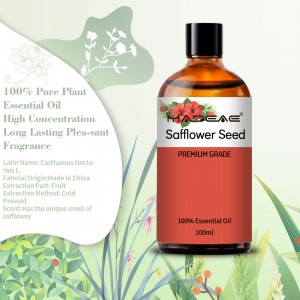Safflower Seeds Oil
Maybe many people have not know safflower seeds oil in detail. Today, I will take you to understand the safflower seeds oil from four aspects.
Introduction of Safflower Seeds Oil
In the past, safflower seeds were typically used for dyes, but they have had a range of uses throughout history. It has been an important plant for cultures dating back to the Greeks and Egyptians. Safflower oil is extracted from the seeds of its plant, which is an annual, thistle-like plant with many branches and little-known use, except for its oil. The health benefits of safflower oil include its ability to lower cholesterol levels, help manage blood sugar, boost hair care and skin quality, and is thought to reduce the symptoms of PMS.
Safflower Seeds Oil Effects & Benefits
- Protects Heart Health
Safflower oil has been shown to have a higher content of unsaturated fatty, a beneficial type of fatty acid that our body needs. It is otherwise known as linoleic acid. This acid is known for beneficial effects, such as reducing inflammation and improving heart health – therefore helping to decrease the chances of developing atherosclerosis, as well as other health conditions such as heart attack and stroke.
- Hair Care
Safflower oil is also rich in oleic acid, which is thought to be moisturizing and beneficial for the scalp and hair. Oleic acid is thought to increase circulation on the scalp, stimulating hair growth and strengthening the follicles. Given these properties, it is often used in topical cosmetic applications as well as consumed as food.
Safflower oil has long been thought of as a good choice for people who are trying their best to lose weight. The omega-6 fatty acid, which safflower oil is rich in, may help the body to burn fat, rather than store it. In certain populations suffering from obesity – such as post-menopausal women with type 2 diabetes, it may help increase lean muscle and lower fasting glucose levels.
- Skin Care
The linoleic acid can combine with sebum to unclog the pores and reduce blackheads, as well as acne (a result of sebum build-up under the skin). In Folk medicine, linoleic acid is thought to help stimulate the regeneration of new skin cells that help clear up scars and other blemishes from the skin’s surface.
- Relieves PMS Symptoms
During menstruation, some women often suffer from terrible pain and discomfort. Again, the linoleic acid in safflower oil is thought to help regulate some of the hormonal fluctuations during menstruation. In turn, this may decrease the severity of some PMS symptoms.
Ji’An ZhongXiang Natural Plants Co.Ltd
Flaxseed Oil Uses
Safflower oil is ideal for high-heat cooking methods like roasting, baking and frying. Because of its distinct color and aroma, it can even be used as a budget-friendly saffron substitute in certain dishes as well.
For topical use, simply add a few drops of the oil to dry, rough or scaly areas of the skin. Alternatively, try mixing it with a few drops of essential oil, such as tea tree or chamomile, and massaging onto the skin.
ABOUT
Safflower has been shown to be a very good analgesic and effective in reducing fever. Pharmacological studies demonstrated that extracts of safflower had several physiological functions, such as anticoagulation, vasodilation, antioxidation, and antitumor activity Fatty acid profiles showed a significant rise in linolenic acid under topical safflower oil treatment.
Precautions: If you have an allergy to ragweed and others in that family, avoid safflower oil, since it is from the same botanical family and can cause allergic reactions of varying severity.
Post time: Oct-27-2023



